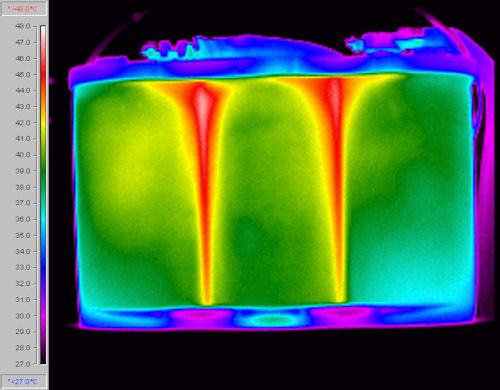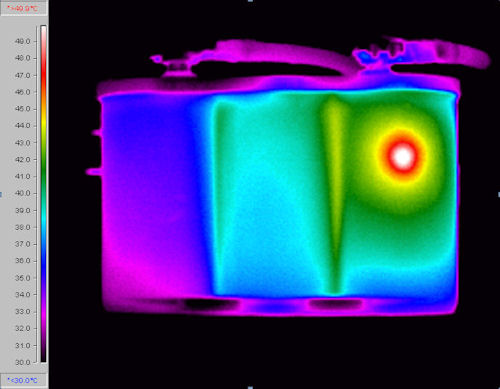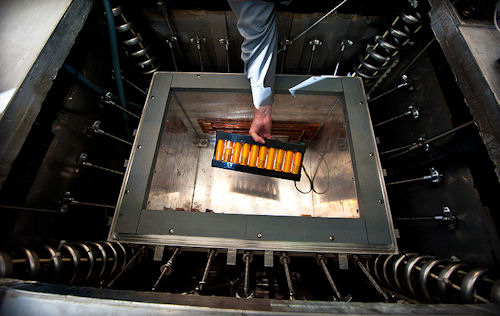Latest News
July 2, 2012
By Debbie Sniderman
While simulation is important to automakers commercializing hybrid-electric vehicles (HEVs) and plug-in electric vehicles (PEVs), industry leaders assert that physical battery testing is critical to avoid issues.
Manufacturers test batteries at multiple levels of complexity, from individual electrochemical cells, through modules, up to complete packs. Though most battery designs withstand a certain degree of abuse and will fail in predictable and controllable ways, manufacturers also perform highly specialized safety and abuse testing to minimize risks and comply with regulations (see “Types of Battery Tests,” page 20).
Comprehensive Testing for Integration
Chrysler and its battery suppliers perform a wide range of functional, durability and reliability tests, says Steve Clark, senior manager in energy storage and high-voltage systems with Chrysler Group’s electrified powertrain engineering organization. Chrysler focuses on tests related to integrating the battery into the complete vehicle system.
 |
| GM accelerates development and expedites production of HEVs, EVs and PEVs with hundreds of battery test channels and thermal chambers at their Global Battery Systems Lab. |
Clark says battery suppliers perform their own testing at the pack, module and cell levels. They outsource abuse-level tests to specialized facilities that have appropriate equipment to manage all potential test outcomes.
“Chrysler coordinates all levels of testing into a single, comprehensive test plan to meet the functional vehicle objectives,” he says.
Several consortia and standards bodies, including the U.S. Advanced Battery Consortium LLC (USABC), the Society for Automotive Engineers (SAE), and the International Standards Organization (ISO), developed comprehensive test methods for HEV and PEV batteries. Chrysler and other auto manufacturers use their tests to characterize and validate their batteries.
Advanced automotive batteries used in HEVs and EVs contain a complex blend of advanced electrochemistry with electronic monitoring and controls.
“Battery packs are large, complex and expensive in the early stages of the technology’s introduction,” Clark says. “This degree of investment into a major vehicle subsystem sets the expectation that batteries operate acceptably over a vehicle’s useful life. Rigorous and carefully planned testing is critical, and affords the automaker confidence in the design and technology it uses to create advanced energy-storage devices.”
Setting Standards
In addition to developing test methods for battery systems in HEVs, PEVs and many other varieties, the USABC, whose members are Chrysler Group LLC, Ford Motor Co. and General Motors, also develops profiles, manuals, requirements and procedures for testing, measuring and data reporting.
It also participates with groups such as the SAE, ISO and the German Automakers Association (VDA) to develop battery standards such as package size, dimensions and tolerances. Ted Miller, who serves on USABC’s management committee, says it is “helping the entire industry develop a set of tests and useful standards that can be relevant worldwide—not for a specific vehicle, but together as automakers.”
Miller says battery testing is critical, and a key step in commercialization processes. The USABC performs collaborative battery testing for everything from performance, life and operating conditions, to actual costs. Some original equipment manufacturer (OEM) locations and a variety of national labs perform USABC tests.
Taking Temperature
One such lab is the National Renewable Energy Laboratory (NREL), which provides thermal battery testing for all types of HEV, PEV and other batteries for many clients, including the USABC. Matt Keyser, who leads its laboratory operations for energy-storage and battery-testing labs, explained the need for infrared (IR) and calorimeter testing during vehicle commercialization.
 |
| This IR image shows a typical heat signature |
Batteries operate efficiently when the temperature is uniform. IR testing takes IR images of a battery while running it through different drive or thermal cycles. Images can reveal if a portion of a cell, an entire cell, a module or a battery pack is hotter than another. Keyser says non-uniformities seen in IR thermal signatures can indicate areas of thermal concern. A region working harder than another can age differently, affecting the cycle length of the battery system under test. IR tests also look at the maximum temperature the cells attain.
 |
This IR image shows internal damage or a “soft short” in a lead acid battery. The damage is not visible when inspecting the battery. |
Calorimeter testing involves placing a battery in a controlled environment and determining how much heat it produces for various drive or thermal cycles. The calorimeter gives critical heat generation and efficiency data at various test temperatures, and can identify how changes to a battery affect its performance. If a manufacturer modifies a battery with a new additive to help low-temperature performance, calorimeter testing can tell how the additive affects performance at high temperatures. “You can’t simulate that. You have to perform the testing,” Keyser says.
Types of Battery Tests Functional electrical tests • Characterize the battery’s electrical capacity as a function of discharge rate or charge state. • Measure the delivery to, and removal of, energy from batteries. • Require specialized assemblies of high-precision power supplies, loads and controls. Functional environmental tests • Expose batteries to various temperatures, humidity and contaminants to verify that they retain functionality. Electrical durability and reliability tests • In rechargeable batteries, focus on the number of charge-discharge cycles and total energy throughput the battery can sustain before losing a specified amount of its usable capacity. Environmental and mechanical durability and reliability tests • Evaluate the battery’s ability to withstand repeated exposure to environmental and mechanical stresses. • Include vibration, mechanical and thermal-shock tests. Safety and abuse tests • Characterize battery cell, module and pack responses under extreme conditions. • Abuse tests include crush, penetration (where a tester drives a sharp object into the battery), overcharge, over-discharge, short circuit, reversal and excessive heat. • Require specialized facilities that test with reduced battery functionality and without electronic monitoring or controls that ensure safe operation. |
Calorimeter testing can also indicate the temperature that crystalline-phase changes occur inside the battery cells when cycled, because some phase changes are endothermic (consume heat). Testing helps establish critical operating parameters such as what state of charge to avoid cycling the battery so as not to crack anode or cathode materials. Combined calorimeter and IR imaging data provides information necessary to design the vehicle’s thermal management system.
“Models are effective, but their fidelity is limited,” Keyser explains. “It is difficult to simulate all pertinent parameters in a model and simulate real-world performance. There’s an obvious benefit to using test data with models to predict the behavior of battery systems in a vehicle.”
Critical Tests
Miller, also the manager of energy storage strategy and research at Ford Motor Co., says, “Ford has found that there is testing that has to be done. There’s always a need to at least perform targeted validation at stages, starting with the basic materials that go into a cell or a finished cell assembly, and extending to the modeling tools, models and expected performance of the entire system.
“When something breaks down at the electrode level on a cell, we remove one or two electrodes and test a half-cell configuration to make sure it delivers the expected performance,” he continues. “Then, we test many half cells coupled together to verify whether the effect is additive and we are getting results we predict.”
Ford also performs critical mechanical tests for terminal durability and compressive stresses, because most batteries in a large array have some degree of compression.
“It is difficult to simulate durability,” Miller says. “We can look at a single event, but when looking at long-term fatigue and wear-out factors, testing is quite important, since it doesn’t have the same degree of predictability. Also, simulations don’t always provide insight. You have to know what you’re putting into the model to get good results from it. There’s not always perfect information in the parameters included.”
Because batteries are susceptible to corrosion, Miller says the entire industry performs humidity tests, placing batteries in high humidity conditions to validate that they are fully sealed from outside environments. Testing also verifies their designs are appropriate for the environment where they’re used.
“Unknown air quality drawn from the cabin of a car may have impurities or moisture that could cause an issue, and sometimes galvanic reactions could occur. Corrosion or leakage is not easily simulated, so you have to test. Humidity testing is important and the place to catch it,” he says. “We also complete many performance tests, which can lead to design changes, such as life-cycling and cycling under dynamic conditions.”
By the time performance tests are run, Miller says, the vehicle has been in development for some time, so a design change “would be a surprise”—although the design could change if something wrong was discovered while testing a whole battery system.
 |
| The Large Volume Battery Calorimeter in NREL’s Energy Storage laboratory. The LVBC is the largest battery calorimeter in the world and can test cells, modules and sub-packs. |
“We probably created a simulation and smaller build-ups, and now have a full pack to test. We know the expected response. If battery performance is well below what’s in simulation, testing could show potential issues with cell technology or cell connection designs,” he says. “Perhaps the welded or bolted connection wasn’t made to procedure, or if there’s a design issue, a lighter-weight piece of copper was included than was needed, testing helps isolate the issues so we can modify it accordingly. Simulations may catch some materials issues, but not issues from a process standpoint. A torque setting may be wrong; we may assume a perfect joining procedure that didn’t happen. Testing could be critical in those cases.”
Testing Closer to the Road
SAKOR Technologies Inc. produces automated testing equipment for many major HEV and PEV manufacturers. Their test system combines a high voltage battery simulator, an AC motoring dynamometer, and an automated data acquisition and control system. It tests complete HEV drivelines or any vehicle sub-system, including emissions.
SAKOR’s test system records a battery’s functional responses to a variety of road load profiles. Manufacturers can test using simulations based on international standards or profiles recorded from real vehicles driven on closed test tracks. By simulating the vehicle’s real dynamic responses, it can test the motor, inverter, transmission, charging system and battery, alone or in combination.
SAKOR President Randy Beattie says most customers perform HEV testing with battery simulators in the dynamometer cell. But physical battery testing is still necessary to validate designs, durability, and performance under continuously changing operational conditions, including different initial charge levels.
“Simulations can predict component performance and durability, but they can’t be used exclusively for reporting energy efficiency, fuel economy or real-vehicle responses to the complex stresses and strains seen on a real course,” he says.
SAKOR also performs emission testing for OEMs in specialty indoor test cells. Beattie says emission tests may also be required because some batteries can emit hazardous gases during normal operating or fault conditions, such as during a short or a large current surge. SAKOR validates the presence of hydrogen or other explosive gases in a test cell that must meet more stringent ventilation requirements than what a battery experiences stored in a vehicle.
Debbie Sniderman is an engineer, writer and consultant in manufacturing and R&D. Contact her at VIVLLC.com.
More Info
Subscribe to our FREE magazine, FREE email newsletters or both!
Latest News
About the Author
DE’s editors contribute news and new product announcements to Digital Engineering.
Press releases may be sent to them via [email protected].





